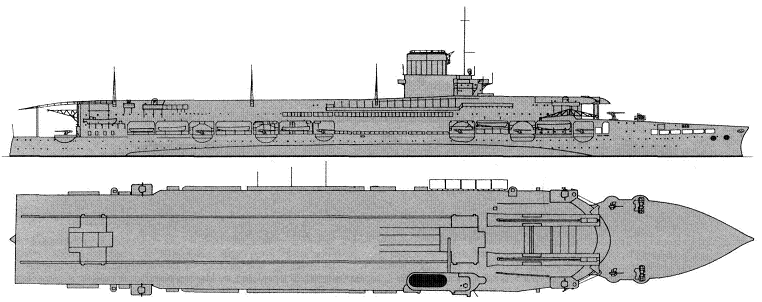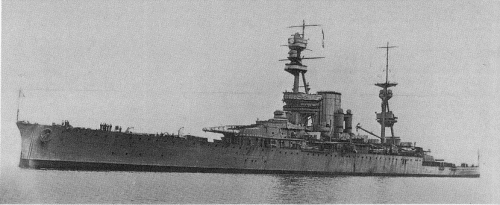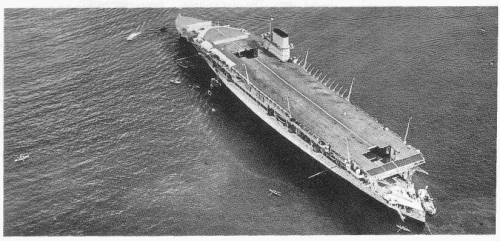

Glorious 1918

Glorious, 1939
| Name | No | Yard No | Builder | Laid down | Launched | Comp | Fate |
| Courageous | 51, 94 | 895 | Armstrong, Elswick | 28.3.1915 | 5.2.1916 | 1.1917 | converted to aircraft carrier 1924 - 1928 |
| Glorious | 67, 56 | 482 | Harland & Wolff, Belfast | 1.5.1915 | 20.4.1916 | 1.1917 | converted to aircraft carrier 1924 - 1930 |
| Data variant | as completed |
|
Displacement normal, t |
19230 |
|
Displacement full, t |
22690 |
|
Length, m |
239.7 |
|
Breadth, m |
24.7 |
|
Draught, m |
7.10 mean |
|
No of shafts |
4 |
|
Machinery |
4 sets Parsons geared steam turbines, 18 Yarrow small-tube boilers |
|
Power, h. p. |
90000 |
|
Max speed, kts |
32 |
|
Fuel, t |
3160 oil |
| Endurance, nm(kts) | 6000(20) |
|
Armour, mm |
belt: 76 - 51, bulkheads: 76 - 51, turrets: 229 (face) - 178 (sides) - 108 (roof), barbettes: 178 - 76, main deck: 38 - 19 (63 over magazines) with 25mm slopes, CT: 254 |
|
Armament |
2 x 2 - 381/42 BL Mk I, 6 x 3 - 102/44 BL Mk IX, 2 x 1 - 76/45 20cwt QF Mk I, 2 x 1 - 47/40 3pdr Hotchkiss Mk I, 2 - 533 TT (beam, 10) |
|
Complement |
828 |
Ship project history as battlecruisers: To get around the Cabinet
ruling against new capital ships Fisher ordered early in 1915 three 'large light
cruisers' which were in fact light battlecruisers intended to support his
proposed Baltic landing. The precise role, like everything else connected with
Fisher`s Baltic plans, was never worked out, but it can be assumed that they
were to provide gunfire support with their heavy guns and possibly to lure away
German forces. To that end their high speed and shallow draught made sense, but
as with the original battlecruisers, the result was a very expensive solution to
the problem. The basis of the design was simply an enlargement of the current
light cruisers, with 51mm armour plating over 25mm shell plating. Even the
machinery was merely that of the light cruiser Champion, doubled to drive
four shafts, and 18 boilers instead of 8. However the design showed that the RN
was at last becoming aware of the benefits of more advanced machinery, for the
combination of small-tube boilers and double helical geared turbines enabled the
Courageous class to develop 90000shp quite easily, when compared with the
42 large-tube boilers needed for 110000shp in the Renown class. This
feature in the design marked a victory for the DNC and E-in-C, who had been
pressing the Naval Staff for some years to get away from heavy uneconomical
machinery. The main improvement was to use small-diameter, fast-running turbines
in place of large-diameter turbines.
The hull form was similar to the Renown class, with an
integral 'bulge' taking the place of an internal anti-torpedo bulkhead. During
construction an additional 37-25mm torpedo bulkhead was worked in between the
barbettes but as they ran inboard of the wing engine rooms they would have been
only partially effective in limiting flooding. As Fisher had already initiated
work on an 457mm gun it was hoped to give the new ships an armament of two
single 457mm, but to get the first two ships into service quickly twin 381mm
were substituted.
The ships were designed to reach 32kts at a load tonnage of
17400t, so that the trial speed of Glorious, 31.25kts at 21270t with
88550shp was highly creditable. Although not too lightly built the great length
of the hull was a potential source of weakness. On 8 January 1917 while working
up to full power during a trial the Courageous suffered buckling of the
forecastle between the breakwater and the 381mm barbette, as well as leaking
fuel tanks, so she was given 130t of stiffening. Although no such damage was
suffered in Glorious, she was also stiffened early in 1918. In addition
to the torpedo bulkhead mentioned earlier, after Jutland both ships were given
extra 25mm plating on the main deck over the magazines. The single large funnel
and long forecastle made them handsome ships but they were even bigger white
elephants than the Renown and Repulse, for which no proper role
could be imagined. In 1917 Glorious was given 12 additional fixed TT
(6x2), one twin abreast the mainmast and 2 twin around the after turret, port
and starboard (Courageous received only 2 pairs abreast mainmast, the
area abreast the turret was used for mine rails). Although Glorious
managed to fire a torpedo from one of her submerged TT at full speed, in
practice this was limited to 23kts as the guidebar was bent by the water
pressure.
As carriers: Courageous was converted to minelayer in April 1917, and order given for removal of rails 23 November 1917. After Armistice both ships were attached to gunnery school and later became flagships of reserve. In the beginning it has been decided to rebuild these ships to aircraft carriers on Furious type. Works on Glorious were commenced in February of 1924, and on Courageous in June, 1924. Ships became operational again in March, 1930 and May, 1928 respectively.
As a whole their design was similar as on Furious, but significantly differed outwardly thanks to island with impressive funnel. A length of the upper hangar have increased to a length of lower one (167.6m), that has allowed to carry up to 48 airplanes.
Protection as battlecruisers: The main belt was constructed from 51mm armour from HT (high tensile) steel on 25mm hull plating between the barbettes. This belt was 8.4m deep, its lower edge was in 1.4m below the waterline, and upper edge was connected with the upper deck. Fwd from 'A' barbette summary thickness of main belt was 51mm (it had some smaller deep), it was closed by 51mm transverse bulkhead, there was additional 76mm bulkhead abreast the 'A' barbette. Aft from the aft engine room also there was a 51mm belt, closed by 51mm bulkhead abreast 'Y' barbette, aft bulkhead of aft engine room (in point of connection of 76mm and 51mm belts) had 76mm thickness.
Turrets had 229mm faces, 279mm rears, 178mm sides and 108mm roofs. 'A' barbette had 178-152mm thickness above the upper deck, 102mm between upper and main decks and 76mm between main and lower decks. 'Y' barbette had 178-152mm thickness above the upper deck and 76mm below the main deck. CT had 254mm sides, 76mm floor and 51mm roof, communication tube had 76mm protection. Main director had 152mm vertical and 76mm horizontal protection. Aft torpedo firing CT had 76mm sides, 38-19mm roof and 51mm armour of communication tube.
Forecastle deck between barbettes had 25-19mm protection, but in area of superstructures was protected only near the sides. Upper deck between fwd 51mm transverse bulkhead and 'Y' barbette had 25mm armour. Main deck under the original design had been 19mm at flat and 25mm at slopes but after Jutland design was renewed and main deck received additional 25mm armour plates. As result its protection was 44mm at flat and 51mm at slopes. Lower deck was 25mm between 'A' barbette and stem and between 'Y' barbette and stern, its thickness was increased to 76mm over steering gear compartment.
Additional 19mm longitudinal amidships bulkhead protected funnel uptakes, this uptakes and ventilator pipes had 38-25mm protection above forecastle deck. There was internal underwater protection with 38-25mm longitudinal bulkhead between "A" and "Y" barbettes, but this bulkhead was placed between center line and outer shafts turbine sets and can not successfully protect the ship machinery, these bulkheads were closed by 25mm transverse bulkheads. Maximal deep of underwater protection was 3.7m.
Ship Protection as carriers: The main belt was constructed from 51mm armour from HT (high tensile) steel on 25mm hull plating between the barbettes. This belt was 8.4m deep, its lower edge was in 1.4m below the waterline, and upper edge was connected with the upper deck. Fwd from former 'A' barbette summary thickness of main belt was 51mm (it had some smaller deep), it was closed by 51mm transverse bulkhead, there was additional 76mm bulkhead abreast former 'A' barbette. Aft from the aft engine room also there was a 51mm belt, closed by 51mm bulkhead abreast former 'Y' barbette, aft bulkhead of aft engine room (in point of connection of 76mm and 51mm belts) had 76mm thickness.
New upper (former forecastle) deck between barbettes had 25-19mm protection, but in area of superstructure was protected only near the sides. Medium (former upper) deck between fwd 51mm transverse bulkhead and former 'Y' barbette had 25mm armour. Main deck was 44mm at flat and 51mm at slopes. Lower deck was 25mm between former 'A' barbette and stem and between former 'Y' barbette and stern, its thickness was increased to 76mm over steering gear compartment.
There was internal underwater protection with 38-25mm longitudinal bulkhead between former barbettes, but this bulkhead was placed between center line and outer shafts turbine sets and can not successfully protect the ship machinery, these bulkheads were closed by 25mm transverse bulkheads. Maximal deep of underwater protection was 3.7m.
Modernizations: 1917, Glorious: + 6 x 2 - 533 TT
1917 - early 1918, both: hull was strengthened
spring 1917, Courageous: + 2 x 2 - 533 TT, 4 mine rails for 222 Elia or 202 H-II mines
1918, both: + flying-off platforms on both turrets
(6/1924-5/1928), Courageous; (2/1924-3/1930), Glorious: were converted to aircraft carriers similar to Furious but with large island superstructure and funnel:
| Data variant | as carriers |
|
Displacement standard, t |
22500 |
|
Displacement full, t |
Courageous: 27560 Glorious: 27400 |
|
Length, m |
224.0 pp 239.8 oa |
|
Breadth, m |
27.6 wl |
|
Draught, m |
8.51 - 8.53 deep load |
|
No of shafts |
4 |
|
Machinery |
4 sets Parsons geared steam turbines, 18 Yarrow small-tube boilers |
|
Power, h. p. |
90000 |
|
Max speed, kts |
30 |
|
Fuel, t |
Courageous: 3685 oil Glorious: 3450 oil |
| Endurance, nm(kts) | 5000(15) |
|
Armour, mm |
belt: 76, decks summary: 76 |
|
Armament |
Courageous: 16 x 1 - 120/40 QF Mk VIII, 4 x 1 - 47/40 3pdr Hotchkiss Mk I, 4 x 1 - 40/39 2pdr QF Mk II, 48 aircraft (Flycatcher fighters, Dart torpedo-bombers, Bison, Blackburn, Fairey III recon planes) Glorious: 16 x 1 - 120/40 QF Mk VIII, 4 x 1 - 47/40 3pdr Hotchkiss Mk I, 4 x 1 - 40/39 2pdr QF Mk II, 48 aircraft (Flycatcher fighters, Dart, Ripon torpedo-bombers, Fairey III recon planes) |
|
Complement |
1216 |
| Year | Fighters | Diving bombers | Torpedo bombers | Recon planes |
| 1928 Courageous | 12 Flycatcher | --- | 12 Dart | 12 Fairey III |
| 1930 Glorious | 12 Flycatcher | --- | 12 Ripon | 12 Fairey III |
| 1935 Glorious | 8 Nimrod, 8 Osprey | --- | 12 Baffin | 18 Fairey III, 6 Seal |
| 1935 Courageous | 9 Nimrod, 3 Osprey | --- | 12 Shark, 12 Baffin | 12 Seal |
| 8/1939 Glorious | 12 Sea Gladiator | --- | 36 Swordfish | --- |
| 9/1939 Courageous | --- | --- | 24 Swordfish | --- |
| 4/1940 Glorious | 18 Sea Gladiator | 11 Skua | --- | --- |
| 6/1940 Glorious | 9 Sea Gladiator | --- | 9 Swordfish | --- |
1934, Courageous: - 4 x 1 - 40/39; + 2 x 8 - 40/39 2pdr QF Mk VIII
1934, Glorious: - 4 x 1 - 40/39; + 3 x 8 - 40/39 2pdr QF Mk VIII
1935, both: + 2 x 4 - 12.7/62
1936, both: 2 catapults fitted (3.65t plane was launched at 104km/h). Length of flying deck increased on Glorious.
1938, Courageous: + 1 x 8 - 40/39 2pdr QF Mk VIII
Aircraft facilities (fd - 5,819 m², ha - 5,095 m² / 23,437 m³): main flight deck: 161.5x27.9 m, short forward flight deck for fighters (forward flight deck was not used since 1936). Upper and lower hangars: 167.6x15.2x4.6m each. Aircraft fuel stowage was 155300l. There were two lifts (5.5 t, 14x14.6m).
Naval service: Both ships were lost in the first year of war. Courageous, searching of enemy transports and submarines in Northern Atlantic, was hit by two torpedoes from German submarine U29 17.9.1939. She has sunk in 15 minutes after attack, 518 people were lost. Glorious participated in the Norwegian campaign. She was intercepted and sunk by German battlecruisers Scharnhorst and Gneisenau 8.6.1940 after the end of covering of evacuation from Narvik. Summary losses of crew and staff of naval and army air groups were 1472 people.
Many thanks to Wolfgang Stöhr for additional information on this page.

Glorious 1918

Glorious 1937

Courageous 1928
© Ivan Gogin, 2008-14